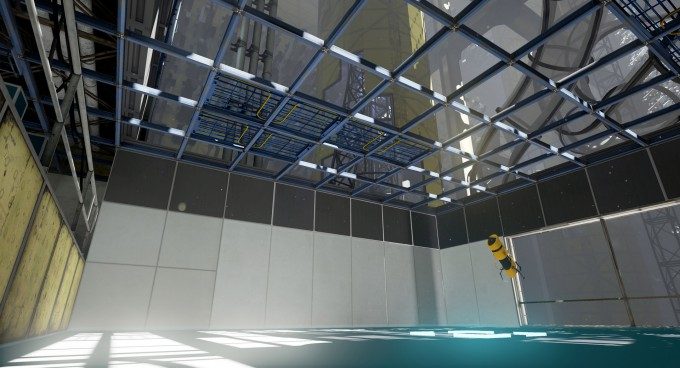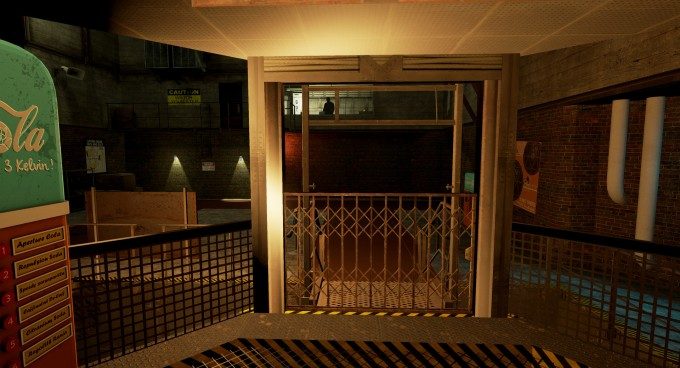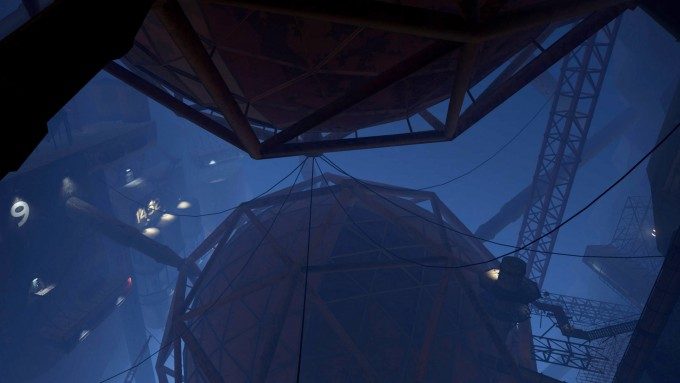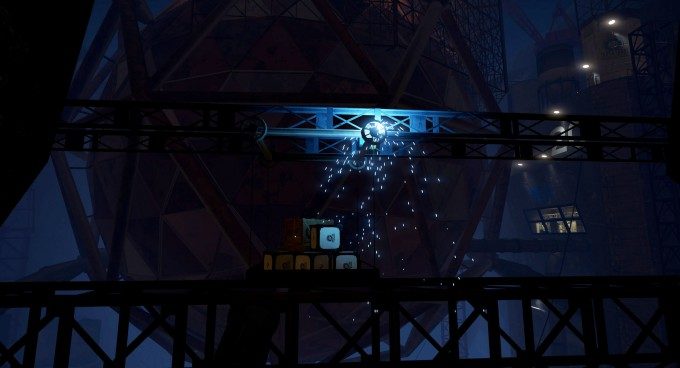When I loaded up Portal Stories: VR I was greeted with familiar sights and sounds from the Portal universe. A disembodied voice told that I was about to take part in an Aperture Science Virtual Reality Experiment, words I was absolutely thrilled to hear.
Portal Stories: VR is a free Portal 2 (2011) “mini story” recently released for the HTC Vive. It was developed by an independent group (Prism Studios) and brings with it 10 brand new puzzles, specifically designed for room scale VR.
Stepping inside, the Aperture Science Laboratory buzzed around me as I looked about, with transparent tubes transporting cubes to and fro, while familiar exposed framework of the immense and mysterious Aperture Science compound sprawls out before me. After taking in the surroundings, I quickly became acquainted with the two tools I was holding.
In my right hand was the Aperture Science Instant teleportation Device which works by pointing where you want to be teleported too and pulling the trigger. This movement system works well and is very comfortable for the VR user. Every time you teleport the controller gives a satisfying buzz letting you know the transfer of matter from one location to the next was successful.
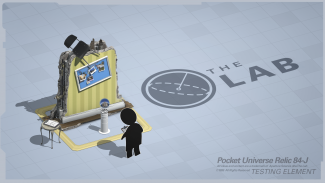
The Aperture Science Instant Teleportation Device serves two purposes in the Portal Stories: VR world. The first is to create comfortable VR movement by replacing the typical movement system of a controller and dual analog sticks. The second is to act as the portals did in the Portal games, creating an interesting way of moving around the environments and puzzles. Sadly, the classic orange and blue portals that are the namesake of the mod do not make an appearance in this relatively short (approximately 30 minute) VR experience.
In my left hand was the Aperture Science Apparatus Retrieval Tool which functions much like the gravity gun in Half-Life 2 (2004). You point it at an object and pull the trigger and the object will be pulled to you. When you release the trigger the item drops in place. This can be used on a number of objects throughout the various puzzles as you progress. To help add difficulty, the player cannot teleport while holding an object with the Retrieval Tool.
After being introduced to the world of Aperture Science I was tasked with completing 10 different levels similar to those seen in the previous Portal games. Each new puzzle is somewhat harder than the previous one and builds on the different skills you acquire as you play. The familiar big red buttons, Aperture Science cubes, lasers, turrets, and emancipation grids appear in these puzzles along with a few new VR-friendly additions.
It was quite satisfying to be able to manipulate a lens cube over my head to redirect lasers precisely where I wanted the beam. I found it much easier to be accurate with my own hands in a 3D virtual space than using a controller or keyboard and mouse to manipulate objects. Ducking down behind walls to hide from the automated turrets was quite terrifying and was my favorite part of the experience!
The overall experience is well polished and feels like a Valve creation. The development team clearly took care to make this game as true to the Portal tiles as possible. However there were some major gameplay differences that subtracted from the overall experience.
The puzzles were not particularly challenging, only ever taking one or two tries for even the most difficult moments, and while the developers did a good job working with what tools they gave themselves, I found myself wondering what could be done to improve the experience. The levels were well thought out and creative, but with the limited tools I had as a player, I never got the ‘AH-HA’ moment of solving a challenging puzzle that the other Portal games gave me.
Removing some of Portal’s better known tools and mechanics is an understandable choice from a developer standpoint. Flying through portals and bouncing off walls via repulsion gel would be a nauseating experience for even the most seasoned veterans of VR. But is the world of Aperture Science still be interesting space to explore without the portals themselves, the fictional corporation’s most impressive invention? For me the answer was no.
I found myself entertained for the first few puzzles, buzzing around the Aperture Science Laboratories like a good little lab rat, but I kept wondering when the puzzles would get interesting or challenging and it simply never happened. Before I knew it the experience was over and I was left in the empty room that I started in, just staring out at Aperture Science Laboratories. The developers did a wonderful job of staying true to the look and feel of Portal using Unreal Engine, but the experience falls short.
While there are a lot of things that Portal Stories: VR does right it takes out one of the coolest and most interesting aspects of the original Portal games, the actual portals. Eliminating portals removes many abilities and functions that helped make the first two Portal games so much fun and such interesting puzzle games. It removed the sense of creativity from the gameplay. A Portal game just isn’t the same without those orange and blue transdimensional portals.
Granted, for a free mod, Portal Stories: VR is worth picking up, especially if you are a diehard Portal fan who will be content simply stepping inside of the iconic Portal world; just don’t expect the same type of varied gameplay that we have grown accustom to from the original games.

